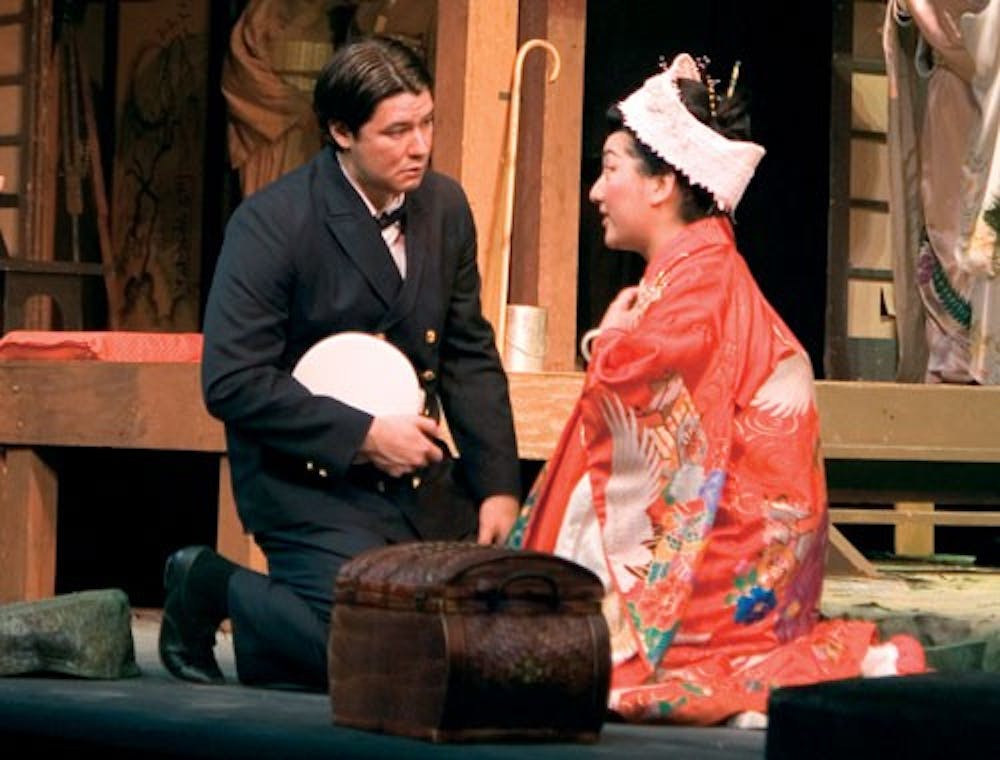Operas are not spontaneously created. They do not appear out of thin air. They require time and effort from many dozens, if not hundreds, of people. Then, like a butterfly breaking from its cocoon, the final theatrical product bursts onto the stage, wings spread and ready for flight.\nNot least among the innumerable individuals involved in bringing a piece of opera to fruition is the director, the one responsible for the dramatic vision that carries the work from overture to final curtain.\nFor this season’s production of “Madama Butterfly,” the beloved opera by Giacomo Puccini, the IU Jacobs School of Music invited guest artist Nick Muni to play the important role of director. Recently appointed to the faculty of the Cincinnati College-Conservatory of Music, Muni has been rehearsing with the cast of “Butterfly” since March.\n“I did visit in February,” he said, “in order to introduce myself and my ideas to the cast, so they could start getting them into their heads.”\nOf course, Muni’s work on “Butterfly” began long before he met the cast.\n“Each time I do an opera, I take time to sort of get out of my head,” he said. “I do a lot of listening to the score, writing down ideas as they come.\n“After I do that, I put all that aside and start doing an analysis of the narrative, see what the issues are and get a really clear idea of the skeleton of the show without going into too much detail.”\nUsually at this point, Muni would share his ideas with a design team – lighting, set, and costume designers – who would use them as starting points in the production process. For this production, however, Muni and the cast will be using the set already held by the Jacobs school.\n“It’s really an exception for me,” he said. “I don’t normally use pre-built sets. It does have an impact on the concept for the show.”\n \nRole prep\nAt about the same time Muni is crafting his vision for the production, cast members, such as master student Ken Pereira, begin taking steps to learn their role. Pereira will be performing the role of Sharpless, the United States consul in Nagasaki, Japan.\n“(The preparation) all starts with the text,” Pereira said over lunch a few days before opening night. “I learn to speak the Italian as if I were an actor, not a singer. Also, I go through the libretto three times – to see what the character says about himself, what other people say about him and what he actually does.”\nThen, Pereira said, he begins preparing the role musically.\n“I’ve been working with my teacher (Andreas Poulimenos), which has been wonderful because he’s pretty well known for the role,” he said.\nPereira described his method of score preparation.\n“I mark with one color all the double consonants, another color for stresses,” he said. “I write in a word for word translation not only for my character, but everyone else on stage, as well as all of my inner monologues.”\nFriend and fellow voice student Rebecca Fay joked, “If you ever need to know anything about the role of Sharpless, you could just look at Ken’s score.” \n“Most of the preparation (for the part) is not singing. It’s studying,” Pereira said. “I go to Starbucks for an hour or so every day and just study. You get it to the point that it’s second nature, and then you have to go back and make it seem like it’s not, like it’s spontaneous.”
Practice, practice, practice\nOnce in the rehearsal room, in the upper levels of the Musical Arts Center, the cast of “Butterfly” must take all their preparation and intention and submit it to the molding and crafting of both director Muni and conductor David Effron. Muni and Effron, who have worked together in the past, clearly view their leadership roles as collaborative, even to the point of chatting about the opera while Effron’s arm is marking beats and waving cues.\nTheir different ideas sometimes prompts new discussions and even restagings.\n“Could you sing that passage more legato?” Effron asked cast member Brad Raymond during a rehearsal last week. After Raymond complied, Muni stopped him and said, “That’s exactly what I was afraid of.”\n“You can sing it legato, sure,” he told Raymond, “but never sad or sweet. This is not a sweet moment.”\nLater, Effron brought up the matter of one of Butterfly’s high notes. “I want that note cut off sooner,” Effron told Muni, demonstrating in his scratchy baritone. \nMuni immediately dropped into his personal space, feeling out for himself the timing of the note and Butterfly’s stage action.\n“Yes, she can release the chair at the moment she releases the note,” he said conclusively.\n“It’s all about the synthesis,” Muni said later. “It’s not a compromise, but an evolution of your ideas. Often, the third idea that comes is better than the other two.”\nMuni is committed to painstaking detail. He directs his actor-singers inward, urging them to meet him halfway.\n“It’s a slow process,” said doctoral student Marcos Aguiar, “but he is very detailed in his approach.”
Final adjustments\nOn the Monday before opening, Muni was holed up in the house of the Musical Arts Center tending to lighting cues, while stagehands fired staple guns at loose pieces of scenery.\n“It’s a 40-year-old set,” joked Muni. “It can be kind of scary.”\nMuni was tending to lighting cues, a time- and labor-intensive process wherein each light setting is programmed into the MAC’s computer and marked in the score when it is to be activated. Some shows clearly require more cues than others.\n“E.J. (technical director at the Buskirk-Chumley Theater) just texted me,” a lighting operator said to assistant director Mihaela Bogdan with a laugh. “They’re halfway into Act 2 (of ‘Amadeus’) and are already up to 357 cues. ... I told him we’re only up to 10.”\nMuni took a minute to reflect on the work he has done in the past month.\n“I’ve really enjoyed it (at IU),” he said. “It’s a large theater, and it’s great being in a university setting. You really feel like you can do more artistically; you don’t have the same pressures of the professional world.”\nMuni, as well members of the cast, expressed optimism for the show.\n“I bet it will be packed,” Aguiar said. “It’s a show everyone wants to see.”






